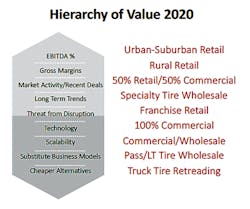I run across a lot of 50-year-old tire dealerships that have a mix of businesses, like the retail tire dealership that opened a warehouse to deliver tires to its stores and then started wholesaling to get more volume, better pricing, and more cash profit.
Or the tire distributor that opened a commercial tire store at its warehouse to serve local commercial contractors or government vehicles.
And how about the commercial tire dealership that has a handful of retail stores, a retread plant and maybe does some wholesaling on the side?
How these businesses got this way is always the same: the owners saw a low-risk opportunity to make money by leveraging what they already were doing in the same geography. In other words, they saw a need and filled it.
The owners of these operations are almost always comfortable with what they have built. But an outsider might look at what they’ve built at some point and go, “Huh?”
While these owners were building a cash machine that worked for them, they also built an operation comprised of business segments that have differing values all their own.
It’s hard to be good at one thing in business, let alone several.
The chart below represents the relative market value of the different segments that you’ll see in the lower middle market of privately held, U.S.-based tire businesses.
It doesn’t apply to large public companies like Monro Inc. or tire distributors the size of American Tire Distributors Inc. or Tire Rack Inc., or even regional, independently owned and operated commercial tire powerhouses. Once you reach a certain size and scale, you’re in a whole different category of value.
A business segment’s place in the hierarchy of value is determined by a mix of things like profitability and margins, positive or negative long-term trends, recent market activity and threats to its business model. Here’s an example of recent market activity impacting commercial tire and specialty tire wholesale segment values.
After more than five years of investment, Palladium Equity Partners LLC sold Raben Tire Co. to Goodyear Tire & Rubber Co. in a deal that was announced this past December. Goodyear, in turn, has shuttered Raben’s specialty tire wholesale division.
Neither of these are particularly positive developments when analyzing commercial tire and specialty tire wholesaler values, right?
It’s hard to be good at one thing in business, let alone several. And rest assured there are national and regional competitors that are focusing on being the best at just one of any of the three or four businesses you might be in.
Enhancing the value of your dealership may involve repositioning and rationalizing your business by fixing, selling or closing unprofitable business lines and re-investing in higher value ones.
So if you’re a multi-store tire retailer with an inventory-heavy wholesale business staffed with people and drivers and are losing $200,000 a year, shut it down, sell off the inventory and invest in your retail stores.
Your overall business value will improve.
Focus on what you can be great at. At a minimum, invest in better financial reporting and disciplined cost accounting to accurately measure your varied businesses so everyone can see where the value is. This will help you capture more value for yourself and not leave it to others. ■
Michael McGregor is a partner at Focus Investment Banking LLC (focusbankers.com/automotive/tire-and-service). He advises and assists multi-location tire dealers on mergers and acquisitions. For more information, contact him at [email protected].




